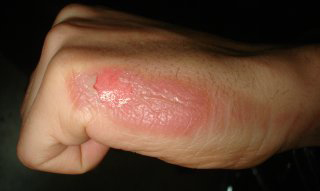
Burns are injuries to the skin and underlying tissues that can lead to pain, blister, swelling and loss of skin.
Burns are usually caused by heat from fire, steam, or hot liquids. However, they may also result from chemicals (acids), ultraviolet radiation (sun exposure), radiation and electricity.
Although minor burns can usually heal spontaneously, severe burns may penetrate into deeper tissues, such as fat, muscle, or bone and require extensive treatment or hospitalization.
Classification of Burns
Burns are classified as minor, moderate, or severe. This classification is based on two factors; a) depth of the burn and b) total area burned.
1) Burn Depth
The depth of injury from a burn is described as first, second, or third degree:
- First-degree burns affect only the top layer of skin (epidermis). These are described as “superficial” burns. First-degree burns are red, swollen, and painful. The burned area whitens when lightly touched but does not develop blisters.
- Second-degree burns extend into the middle layer of skin (dermis). These may be referred to as “ partial-thickness” burns. Second-degree burns are pink or red, swollen, and painful, and they develop blisters that may ooze a clear fluid. The burned area may whiten when touched.
- Third-degree burns extend through all three layers of skin (epidermis, dermis, and fat/muscle). These burns also harm the sweat glands, hair follicles, and nerves. These are called “full-thickness” burns. Third-degree burns usually are not painful because the nerves have been destroyed. The skin becomes leathery and may be white, black, or bright red. The burned area does not whiten when touched, and hairs can easily be pulled from their roots without pain.

2) Burn Area
- Minor burns: All first-degree burns as well as second-degree burns that involve less than 10% of the body surface usually are classified as minor.
- Moderate and severe burns: Burns involving the hands, feet, face, or genitals, second-degree burns involving more than 10% of the body surface area, and all third-degree burns involving more than 1% of the body are classified as moderate or severe.
NOTE: The appearance and symptoms of deep burns can worsen during the first hours or even days after the burn.
Complications of Burns
- Minor burns are usually superficial and do not cause significant complications. First- and some second-degree burns heal in days to weeks without scarring.
- Second-degree and third-degree burns can cause scar tissue to form. This scar tissue contracts as it heals. If the scarring occurs in a limb or digit, the resulting contracture may restrict movement of nearby joints. Deep second-degree and small third-degree burns take weeks to heal and usually cause scarring. Most require skin grafting.
- Severe burns (and some moderate burns) can cause serious complications due to extensive fluid loss and tissue damage. These complications may take hours or days to develop. People with severe burns may require hospitalization to manage complications; including hypotension (low blood pressure), dehydration and shock. Electrocardiography (ECG) and chest x-ray may be ordered and tests of blood and urine are done to detect proteins caused by the destruction of muscle tissue (rhabdomyolysis) that sometimes occurs with deep third-degree burns.
Treatment of Minor Burns
First-aid measures at home may be all that is necessary to treat small, shallow burns that are clean.
Running cold water over the burn can help relieve pain. In general, a clean burn is one that affects only clean skin and that does not contain any dirt particles or food.
Covering the burn with an over-the-counter antibiotic ointment and a nonstick, sterile bandage can help prevent infection.
A doctor's examination and treatment are recommended if a tetanus vaccination is needed and if the burn has the following traits:
- The burn is larger than the size of the person's open hand
- Blisters appear at the site of the burn
- The burn involves the face, hand, foot, genitals, or skin folds
- The wound is not entirely clean
- Pain persists longer that one day after the burn
Treatment of Serious Burns
A serious burn may require admission to a hospital or frequent re-examination at a hospital or doctor's office, possibly as often as daily for the first few days.
Severe burns may require a skin graft to repair the damaged area.
Graphic image courtesy of K. Aainsqatsi
Reference: National Institute of General Medical Sciences
Source: Vivacare
Last updated : 1/8/2019